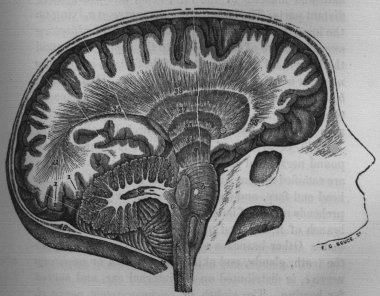Franz Joseph Gall (1758-1828) the originator of what later became phrenology.
 Franz
Joseph Gall was born in the Swabian village of Tiefenbronn near Pforzheim,
which was later in the German Grand-Dutchy of Baden, the sixth of ten children
of Roman Catholic merchant parents. Although originally intended for the
priesthood, and first educated by his priest uncle, Gall studied medicine
in the French city of Strasbourg in 1777. There Gall was introduced to the
comparative anatomy of Johann Hermann (1738-1800) who taught that there
was a close relationship between Man and apes. In 1781 Gall continued his
medical studies in Vienna where he was most impressed by his teacher, the
well-known physician Maximilian Stoll (1742-1787). Stoll emphasized the
collection of many empirical facts from clinical observation before drawing
general conclusions, a theme which would permanently become part of Gall's
practice and rhetoric. Gall received the doctor of medicine in 1785 and
became a successful, well-connected, private physician in Vienna. He married
for the first time in 1790. Gall was very proud and independent; he even
rejected an offer in 1794 to become the personal physician to emperor Franz
II - merely to preserve his independence. Gall's character was not the least
important ingredient in forming his system. His three main passions were,
as Ackerknecht writes: "science, gardening, and women."
Franz
Joseph Gall was born in the Swabian village of Tiefenbronn near Pforzheim,
which was later in the German Grand-Dutchy of Baden, the sixth of ten children
of Roman Catholic merchant parents. Although originally intended for the
priesthood, and first educated by his priest uncle, Gall studied medicine
in the French city of Strasbourg in 1777. There Gall was introduced to the
comparative anatomy of Johann Hermann (1738-1800) who taught that there
was a close relationship between Man and apes. In 1781 Gall continued his
medical studies in Vienna where he was most impressed by his teacher, the
well-known physician Maximilian Stoll (1742-1787). Stoll emphasized the
collection of many empirical facts from clinical observation before drawing
general conclusions, a theme which would permanently become part of Gall's
practice and rhetoric. Gall received the doctor of medicine in 1785 and
became a successful, well-connected, private physician in Vienna. He married
for the first time in 1790. Gall was very proud and independent; he even
rejected an offer in 1794 to become the personal physician to emperor Franz
II - merely to preserve his independence. Gall's character was not the least
important ingredient in forming his system. His three main passions were,
as Ackerknecht writes: "science, gardening, and women."
By 1792-3 Gall
was convinced that he had discovered localized regions of the cerebral cortex
where innate universal faculties resided. Gall called these regions "organs",
a term which was by then common in Vienna for localized brain modules. The
particular faculties of Gall's psychology and organology reflect the cases
in the asylum and in local prisons from which he made many of his first
generalizations, viz. Mord/Würgsinn (faculty of murder) and
Diebsinn (faculty of larceny) and from peculiarities in his own patients.
Gall began to collect human and animal skulls and wax moulds of brains from around 1792 in order to study the development of the cranial contours with the characteristic behaviours associated with a species of animal, or a well-known general or robber. His collection of skulls, as well as plaster casts of heads and skulls, became so extensive, and his energy in collecting them so conspicuous that he became a local celebrity. By 1802 the collection consisted of 300 human skulls and 120 plaster casts.
Gall called his new system "organology" and "Schädellehre" (doctrine of the skull) and later simply "the physiology of the brain". Gall is justifiably remembered as a highly innovative brain anatomist. Although he had no formal anatomical qualifications, Gall made the cerebral cortex (the thin outer grey layers of the cerebrum, in German it is called the brain's 'rind') the centre of attention in place of the ventricles. Since Galen (129-199) the ventricles had been treated as the most important parts of the brain and the cortex was considered only a protective layer.
See: Images of the brain from Gall & Spurzheim's 1812 Atlas
Even in 1796, the same year that Gall began to lecture on his system, the highly respected German anatomist Samuel Thomas Soemmerring (1755-1830) published his Über das Organ der Seele (On the Organ of the Soul). In the second part Soemmerring tried to locate the sensorium commune (or "the soul") in the intraventricular cerebral spinal fluid. Like Descartes' theory that the soul acted through the pineal gland, Soemmerring's idea was never very well received. While his contemporary imagined a locus for the influence of a soul, Gall taught that psychological phenomena take place in specific regions in the cerebral cortex while soul and mind were otherwise ignored. Gall described the nervous system as composed of a multitude of independent nervous centres. His assignation of specific psychological functions to otherwise undifferentiated regions of cortex and the cerebellum is the modern starting point for cerebral localization. Although having been independently postulated many times in the past, localization has been continuously applied and modified ever since Gall, and he is now seen as the founder of cerebral localization.
Gall developed an innovative method for dissecting the brain which revealed the developmental relationships between its parts. Instead of slicing into the entire brain from above as other anatomists of the time, Gall dissected from below, following the medulla oblongata (the brain stem) upwards into the brain, tracing out the fanning fibres which reach into all corners of the brain. Gall claimed to have discovered that the nerves flowed not to a centre, but outwards in all directions, and hence there was no central control centre but instead diffuse and localized modules throughout the surface of the brain. Gall described the brain as the continuation of the spinal cord and claimed to have discovered that the brain is made of "bundles of threads" rather than a pudding-like substance. His claims to be able to be able to separate these fibres were highly controversial- partly for the reason that it appeared to refute any possibility for a single centre of control. Gall appears to have been the first anatomist to have paid close attention to the windings of the cerebrum (the gyri) which had hitherto been ignored and inaccurately represented as arbitrary.
With his ideas of localization, Gall was the first person to create a theory of localized mental illness. For Gall, mental illness was brain illness. Gall spoke for a more gentle handling of the insane wherever he went. In addition, Gall was the first to push the distinction between criminal responsibility and crime as the result of somatic defects. Gall reacted strongly against what he perceived as the French sensualist philosopher Claude-Adrien Helvétius' (1715-1771) extreme belief in learning to the exclusion of congenital abilities. Gall emphasized the opposite and was therefore often accused of fatalism and determinism. In one sense Gall's efforts were in effect a drive to displace an existing vocabulary for discussing psychological behaviour with his own.
Gall's system first appeared in print in December 1798 when one of his letters was published in the main literary journal of the Holy Roman Empire, Der neue Teutsche Merkur, edited by the poet Christoph Martin Wieland. Wieland included a note with the letter assuring his readers that all would find Gall's system of importance, as Dr. Gall was a special and uniquely qualified authority. Indeed, Gall was believed for many years to posses a unique authority partly from his emphasis on his many observations in the Viennese medical institutions and because of his rhetoric of relying on Nature to bring him to conclusions. During phrenology's later career, the claim that the system was founded on untold numbers of observations never faded, though time and place were forgotten.
An unexpected event changed Gall's system from a Viennese curiosity to an international subject. For six years Gall gave public lectures on his system in his home during which time three German pamphlets were published on the subject of Gall's system by 1801 and there was a single mentioning of him in a British periodical. Gall planned to publish a large multi-volume work on his system entitled Lehre über die Verrichtungen des Hirns, und über die Möglichkeit, die Anlagen mehrerer Geistes- und Gemuthseigenschaften aus dem Bau des Kopfes, und des Schedels des Menschen und der Thiere zu erkennen (Doctrine of the Functions of the Brain, and the possibility of recognizing the tendency of several properties of mind from the structure of the heads and skulls of humans and animals). Before his work could be published Gall's lectures were banned by the emperor Franz II in December 1801. The text of the decree provides several reasons for the ban: the enthusiasm with which Gall's system is discussed, that some might get carried away, the attendance of ladies, and that perhaps the system might lead to materialism and thereby go against the "the first principles of morality and religion". The ban also proscribed any publication of Gall's system.
On 6 March 1805, Gall, then forty-seven, the twenty-nine year old Spurzheim as Gall's famulus and dissectionist, Gall's servant, his wax modeller, two monkeys, and the greater portion of Gall's collection of skulls and casts left for Berlin on what Gall intended to be a journey of some months duration.
|
Sketch of Gall lecturing in Berlin in 1805. (Do you recognize others in this sketch? Please contact me if you do.) |
 Gall
and his craniological system soon became an international sensation. From
Berlin Gall received invitations to lecture in further cities, universities
and courts throughout Europe causing him to continually extend his tour.
Gall and his motley company eventually travelled to more than fifty cities
throughout Germany, Denmark, The Netherlands, Switzerland, and France- all
the while steering clear of the battles of the Napoleonic wars. (see map
of the tour) With very few exceptions, Gall was a great success
everywhere he went. Lecturing to most of the crowned heads of Europe, in
all the major universities in Germany as well as before science societies,
as in Kiel, or in posh hotels, Gall covered a large expanse of social as
well as geographic territory. Gall's success may not have been due solely
to his own style and system, but to the allegiances and interests of his
audiences.
Gall
and his craniological system soon became an international sensation. From
Berlin Gall received invitations to lecture in further cities, universities
and courts throughout Europe causing him to continually extend his tour.
Gall and his motley company eventually travelled to more than fifty cities
throughout Germany, Denmark, The Netherlands, Switzerland, and France- all
the while steering clear of the battles of the Napoleonic wars. (see map
of the tour) With very few exceptions, Gall was a great success
everywhere he went. Lecturing to most of the crowned heads of Europe, in
all the major universities in Germany as well as before science societies,
as in Kiel, or in posh hotels, Gall covered a large expanse of social as
well as geographic territory. Gall's success may not have been due solely
to his own style and system, but to the allegiances and interests of his
audiences.
The Edinburgh Medical and Surgical Journal, March, 1806 reported:
The craniology of Dr. Gall was the favourite topic of the German literati during the summer of 1805 at almost every university and capital of the Northern Provinces of Germany . . . In the beginning of last spring the doctor set out for Berlin, and lodged in the house of his intimate friend, Mr. Kotzebue. He there met with universal acceptance. The King, the Queen, princes and princesses, interested themselves so much in his discoveries that he obtained an invitation to go through a course of lectures in presence of the Royal Family, during which the Queen inspected the dissection of a human brain, while the doctor demonstrated the whole series of his astonishing discoveries... A rancorous attack was now commenced against his theory by Dr. WALTER, leading anatomist in Berlin, but it failed of the intended effect, every person being convinced that he was dictated by envy. On the opposite side, the justly renowned Dr. HUFELAND, first physician to the King, almost all the faculty, as well as others professed their full assent, and several interesting tracts were published, in which ample justice was done to the theory ... Dr. Gall visited the houses of correction and prisons in Berlin and Spandau, and gave the most convincing proofs of his ability to discover, at first sight, such malefactors, thieves, and men of particular talents as were amongst the convicts and prisoners. At Torgau, where he also visited a house of correction, Professor BÖTIGER accompanied him, who afterwards published Gall's observations, an abstract of which is given in this article...
Johann Gottlieb Walter (1734-1818) in his etwas über Hn. Dr. Gall's Hirnschädel-Lehre; Dem Berliner Publikum mitgetheilt. (Berlin, 1803, 1805) wrote of the fears that Gall's system was a dangerous form of determinism or fatalism:
With great ease Gall differentiated the more distinguished thieves from those less dangerous, and in every case gave a description which tallied with the record of the trial of the prisoner. ".'he disposition to thieving was most marked in the prisoner Columbus, and amongst the youths in the head of little with reference to whom Gall advised that he should be kept in prison for life, as he will never be anything else than a "good-for-nothing." In both cases the acts of the trial showed an abnormally active disposition to thieving. What man of feeling, for morality and religion will be able to read this without amazement? A fanatic advised the perpetual internment of a child, which has stolen once and is supposed to have an imaginary organ of thieving. Mankind must revolt when it hears that a preacher of fatalistic theories promulgates teaching which would be abhorred even by the most savage people without morals and religion. And shall nations accept them who believe in Christ and revere His preaching of charity? And we fill the pockets of such a man and engrave medals in his honour: It is lucky for Berlin that Dr. Gall held his Fatalism Sermon in the presence of intelligent and just judges; in any other place it might have had dangerous consequences.
After meeting some of the most prestigious learned men of Europe, Gall arrived in Paris in October 1807 where he received the most enthusiastic and perhaps also the most profitable reception so far. The presence of the quasi materialist ideologues in Paris made Gall feel quite at home. Although originally intending to continue his tour, Gall made Paris and its environs his home until his death in 1828. See my bibliography of Gall's works.
See my article on Gall: 'The authority of human nature: the Schdellehre of Franz Joseph Gall', BJHS, 2002.
On Gall see also the following online texts:
Gall, F.J., letter to Retzer, 1798.
Goyder, David, G., My Battle for Life: The Autobiography of a Phrenologist. 1857.
Gall, F.J., & Spurzheim, J.G., Anatomie et physionomie du système nerveux en général et du cerveau en particulier . Premier volume. Anatomie et physiologie du système nerveux en général et anatomie du cerveau en particulier . Paris, F. Schoell, 1810; Gall, F.J., & Spurzheim, J.G., Anatomie et physionomie du système nerveux en général et du cerveau en particulier . Premier volume. Anatomie et physiologie du système nerveux en général et anatomie du cerveau en particulier . Paris, F. Schoell, 1810; Gall, F.J., & Spurzheim, J.G., vol 2, 1812; Gall, F.J., vol 3 ,1818; Gall, F.J., vol 4, 1819.
Gall, F.J., & Spurzheim, J.G., Des dispositions innées de l'âme et de l'esprit : du matérialisme, du fatalisme et de la liberté morale, avec des réflexions sur l'éducation et sur la législation criminelle Paris, 1811.
Gall, F.J., & Spurzheim, J.G., Recherches sur le système nerveux en général, et sur celui du cerveau en particulier Paris, 1809.
Gall, F.J., Discours d'ouverture, lu... à la première séance de son cours public sur la physiologie du cerveau, le 15 janvier 1808 / par M. le Dr Gall. Paris : F. Didot, 1808
Gall, F.J., Sur l'origine des qualités morales et des facultés intellectuelles de l'homme : et sur les conditions de leur manifestation. Paris : J. B. Baillière, 1825.
See also portraits of: Johann Gaspar Spurzheim - The Combe brothers
+ Many thanks are due to Wolfgang Schütz for providing a scan of this engraving in his collection.
++ I am very grateful to Wolfgang Schütz & the Heimatverein von Weil der Stadt for giving me this engraving after my lecture on Gall in December 2001.
© John van Wyhe 1999-2011. Materials on this website may not be reproduced without permission except for use in teaching or non-published presentations, papers/theses.